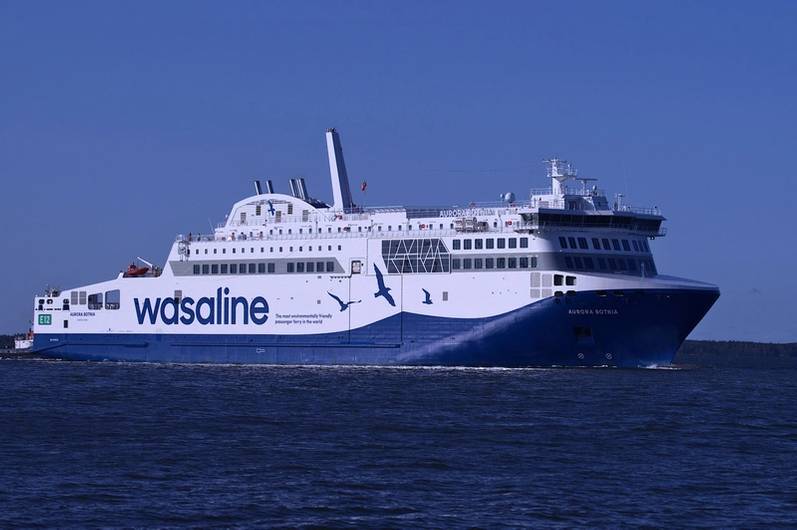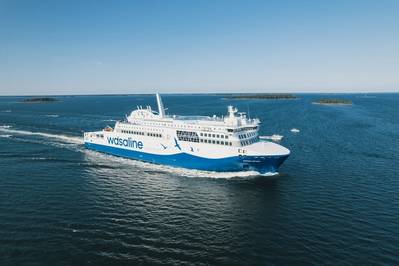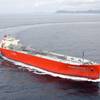Aurora Botnia - RoPax Ferry + Greentech Proving Ground
Built by Rauma Marine Constructions, in Rauma, Finland, and launched in 2021, the 150-meter-long Aurora Botnia boasts a long list of onboard equipment that help it to earn its “green” designation, a label that is confirmed via a Clean Design notation from classification society DNV. The ship is also compliant with the International Maritime Organization’s (IMO) 2030 greenhouse gas reduction target.
Wasaline CEO Peter Ståhlberg describes Aurora Botnia as “a masterpiece of cooperation” and noted that the vessel is over 80% domestic made.
"I'm really proud of the Aurora Botnia. It has been a dream job to make the design,” Ståhlberg said. Starting from scratch, Wasaline was able to work with its supply chain partners in Finland and abroad to choose all of the technology it wanted on board.
At the heart of the vessel are four Wärtsilä 31DF dual-fuel engines that can burn liquefied natural gas (LNG) and/or biogas. The medium-speed four-stroke engines are part of a highly efficient hybrid solution that includes a 2.2 MWh battery energy storage system (ESS) from Swiss-based Leclanché. Denmark-based Danfoss provided liquid-cooled 6 MW AC drives for power and hybrid propulsion systems, and Finnish company VEO supplied a hybrid switchboard solution.
The vessel is equipped with a pair of 5.8-MW Azipod electric propulsion units from ABB (also in Finland), which claims the technology can unlock fuel savings of up to 20% compared to traditional propulsion.
Finland-based WE Tech Solutions developed the electrical design and vessel’s power generation and hybrid propulsion system, propulsion switchboards, propulsion frequency converters, generators, energy management system, propulsion control system and bow thruster motors.
In addition to the engines, Wärtsilä also supplied its LNGPac technology for LNG storage, supply control and monitoring, as well as systems for thrusters and propulsion control, hybrid energy management, navigation and exhaust treatment (all the Wärtsilä equipment and systems are covered by a 10-year Wärtsilä optimized maintenance agreement).
Kenneth Widell, Senior Project Manager, Sustainable Fuels & Decarbonization at Wärtsilä, explained that the engines are most efficient when operating at higher power. The hybrid solution gives the opportunity to operate fewer engines at a higher power rating for better efficiency, while the battery pack is there for peak shaving and as spinning reserve to optimize engine operation. The batteries also provide power for maneuvering in port for the vessel’s hotel load.
Ståhlberg said the vessel is also very well planned and built for efficient loading and unloading in port, where it connects to shore power for emissions-free stops. During the summer, the vessel makes four trips per day. During each 45-minute port call, the vessel unloads about 200 cars, 12-15 lorries and 900 people before taking the same numbers back onboard for the return voyage. Aurora Botnia has 1,500 lane meters of capacity, and its cargo deck are strengthened and designed with extra height for transport of larger and heavier cargoes such as wind turbine components.
Continuous Improvement
Through an agreement with Wasaline, Wärtsilä is able to utilize the vessel as an R&D test platform and technology demonstrator. “Aurora Botnia is a floating R&D laboratory and under continuous development and optimization,” Ståhlberg said.
As an example, Wärtsilä piloted a new ultra-low-emissions version of its Wärtsilä 31DF engine aboard the ship to help prove the technology before bringing it to market. On a weighted average, this new technology can reduce methane emissions by 41% compared to the standard Wärtsilä 31DF engine, the manufacturer said. Wasaline was able to reduce the Aurora Botnia’s methane emissions by 10%.
In addition, Wärtsilä’s data monitoring and analytics capabilities give insights into the vessel’s performance, unlocking further operational and technical efficiencies. “It's not only about collecting data, it's also about the optimization of the operations,” Widell said.
“These waters are very shallow, so depending on where you operate, wind, water depth, trim speed has a clear impact on the power requirement.” Widell said. “If you can manage those parameters, you can optimize the operation.”
The monitoring technology gives crew instant feedback on the decisions they make and their impact on emissions, Widell said.
Ståhlberg agreed and said the advanced onboard technology is a big motivator for the ship’s crew, who continually work to find ways to improve operations and save energy. He cited a current crew-initiated project to use heat recovery and said captains and crew even compete to use as little fuel as possible during crossings. “When somebody [achieves] a record, there is cake in the mess room for the whole crew,” Ståhlberg said. “It's a big event.”
“Everybody at Wasaline is working toward [sustainability],” Ståhlberg said. “Everybody's committed.”
Wasaline has been able to slash its emissions each year since Aurora Botnia entered service in 2021. During the vessel’s first full year in operation, the ship primarily ran on marine gasoil due to higher LNG costs, and Wasaline was able to cut total CO2 emissions by 51.8% (calculations based on data from 2022 and 2013, the first operating year of Wasaline’s previous ferry, Wasa Express, which burned heavy fuel oil and marine diesel). As of October, its CO2 emissions for 2023 were down about 22% compared to 2022, mainly due to increased use of LNG. And the company hopes to continue these reductions through further actions; Ståhlberg hopes Wasaline can be carbon neutral by 2030.
In October, Wasaline launched “Green Corridor Fridays”, which saw the Aurora Botnia operate with certified biogas one day a week from October 13 through the end of December, in preparation for the EU emissions trading system that will come into force in 2024. With certified biogas, all Friday departures were climate neutral.
The move was taken to gauge interest from cargo companies and hopefully build future support for the endeavor, as biogas is more expensive than the LNG currently used as Aurora Botnia’s primary fuel. For now, Wasaline will cover the extra costs, but it hopes customers will put their support behind more sustainable methods of transport. “It's a little bit chicken and egg. Everybody wants to go to green solutions, but nobody wants to pay for it,” Ståhlberg said. “This cannot happen if a shipping company has to carry all this cost itself. It's impossible. We cannot do it.”
Wasaline is also working with Wärtsilä to explore potential of converting two of the vessel’s generators to run on e-methanol, which will soon be locally produced. “I see it as a very good option . . . It's fully realistic,” Ståhlberg said. “When we built the ship, the whole design was created so that we can upgrade all the time.”
The Route
Wasaline is the northernmost shipping line in the world that transports passengers and freight daily, operating the 3.5- to 4-hour transit between Vaasa, Finland and Umeå, Sweden. As such, the Aurora Botnia is built to 1A Super Ice Class.
The line is maintained via a unique cross-border cooperation between the city of Vaasa and the Umeå municipality. Kvarken Link, owned by Umeå Kommunföretag AB and the city of Vaasa, owns the ferry Aurora Botnia. NLC Ferry, a subsidiary of Kvarken Link, operates the route, and Wasaline is the brand name used by NLC Ferry.
 Photo: Wasaline
Photo: Wasaline
- Wasaline by the numbers (2022)
- Passengers: 267,757
- Vehicles: 55,661
- Cargo Units: 22,191
- Busses: 413
- Departures: 1,133
- CO2 Emissions: -19.6%
- Revenue: 29.3 million euros
- Employees: 120-150
- Aurora Botnia Main Particulars
- Ship Type: RoPax Ferry
- Shipbuilder: Rauma Marine Constructions
- Material: Steel
- Ship Owner: Kvarken Link
- Ship Operator: NLC ferry (Wasaline)
- Ship Designer(s): Foreship (outline) RMC (build)
- Delivery Date: August 2021
- Classification: DNV, Finnish Ice Class 1A Super; SOLAS 2020; Stockholm Agreement
- Flag: Finland
- Length, (o.a.): 150 m
- Length, (b.p.):137.02m
- Breadth, (molded): 26 m
- Draft, (designed): 5.95m
- Draft, (scantling): 6.1 m
- DWT (at design draft): 3,500 t
- GT: 24,300 t
- Speed: 20 knots
- Passengers: 935
- Lane meters: 1,500
- Cabins: 68
- Public Decks: 2
- Equipment list
- Main engines: 4 × Wärtsilä 8V31DF (4 × 4,400 kW)
- Fuel type: LNG, biogas, battery (Leclanche)
- Total installed power: 17,6MW
- Bow thrusters: Wärtsilä FPP 2*1500kW
- Propulsion: ABB Azipods (2 × 5.8 MW)
- Generators: WEG
- Engine controls: Wärtsilä (Valmarine)
- Radars: Wärtsilä (SAM)
- Depth Sounders: Wärtsilä (SAM)
- Auto Pilot: Wärtsilä (SAM)
- Radios: Wärtsilä (SAM)
- AIS: Wärtsilä (SAM)
- GPS: Wärtsilä (SAM)
- GMDSS: Wärtsilä (SAM)
- SatCom: Wärtsilä (SAM)
- Mooring Equipment: Kongsberg
- Fire extinguishing systems: Marioff
- Fire detection system: Consilium
- Heat exchangers: Alfa Laval
- Motor starters: Promeco
- Marine Evacuation System: Viking Life Saving
- Coatings: Jotun
- Ballast Water Management System: Norwegian Greentech












